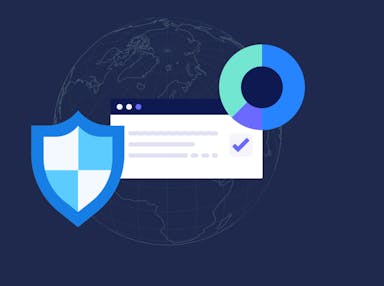
Artificial Intelligence: The Next Big Leap for Security Compliance
Advances in artificial intelligence (AI) systems are having a major impact on organizations across sectors, with more businesses looking to leverage AI to make internal processes more efficient and effective. From providing personalized customer support to predictive data analytics and AI-powered automation, the current and potential applications for AI are seemingly limitless.
If you're operating in today's cloud and data-driven world, you're no stranger to the pressing demands of security compliance. As we wade into the future of digital innovation, organizations are embracing the power of artificial intelligence to protect sensitive data, strengthen their security practices, and simplify compliance.
What's all the fuss about AI and security compliance? Let’s dive into the many ways AI can improve cybersecurity and streamline compliance efforts.
What is AI? Understanding artificial intelligence
To say artificial intelligence is having a moment would be an understatement. But what exactly is meant by AI — Siri? ChatGPT? Skynet? How does AI work and what are the different types?
Artificial intelligence (AI) works by leveraging algorithms and computational models to perform tasks that would otherwise require human intelligence. These tasks can range from simple decision-making to complex problem-solving and learning capabilities. Machine Learning, a subset of AI, takes those capabilities a step further by allowing the system to learn and improve from experience, without being explicitly programmed.
AI can be broadly categorized into two main types: Narrow AI and General AI. However, there are additional subcategories when you dive even deeper. Here's a quick breakdown:
- Narrow (or Weak) AI: This type of AI is designed to perform a specific task, such as voice recognition, recommendation systems, or image recognition. It operates under a limited context and can't engage in tasks beyond its programming. Examples include Apple’s Siri, Google Assistant, Amazon's Alexa, and autonomous vehicles.
- General (or Strong) AI: General AI systems can understand, learn, adapt, and implement knowledge from one domain into another. This form of AI can independently solve problems, understand complex concepts, and even exhibit emotional intelligence. Currently, General AI is a concept more rooted in theory and future development than present-day reality.
Within these two main categories are different types of AI technologies, including:
- Machine Learning (ML): ML systems can learn and improve from experience. These systems identify patterns in data and make predictions or decisions without being explicitly programmed to do so. ML includes subsets such as deep learning and neural networks.
- Natural Language Processing (NLP): This technology allows AI systems to read, decipher, understand, and make sense of human language in a valuable way.
- Expert Systems: These are AI programs that use a knowledge base of human expertise for problem-solving. They are designed to provide expert-quality decisions in specific domains like healthcare, finance, and engineering.
- Robotics: This branch of AI focuses on creating machines that can move and react to sensory input, such as computer vision. Robots can perform tasks in place of humans, especially in dangerous environments or manufacturing processes.
- Speech Recognition: AI systems with this capability can understand spoken language and convert it into text or commands, as with voice search.
These categories can often overlap or be combined in real-world applications, leading to even more diverse AI solutions.
How today’s SaaS companies are using the power of AI for security compliance
Now that we’ve established the current state of AI capabilities, let's shift our focus to how AI can help organizations achieve and maintain compliance with security frameworks and industry standards.
Automated security and compliance monitoring
Frameworks such as SOC 2, ISO 27001, HIPAA, and PCI DSS require organizations to continuously monitor the operating effectiveness of their security controls. AI can automate this process, continually analyzing systems, controls, and processes against compliance and regulatory standards and alerting security teams to any deviations or potential security risks. This real-time visibility saves time, reduces human error, and increases the overall efficiency of compliance efforts.
Recommended Reading

6 Benefits of Continuous Monitoring for Cybersecurity
Intelligent threat detection
Machine learning algorithms can sift through mountains of data to identify patterns and anomalies that could indicate a security threat. By learning from each interaction, the AI gets smarter, making it more efficient at detecting and predicting potential threats. This proactive approach to threat detection is crucial in maintaining compliance and enhancing cloud security.
Faster incident response
Effective incident management is a key requirement for many compliance frameworks, including SOC 2 and ISO 27001. In the event of a data breach or attempted breach, AI systems can help to quickly identify the source of the leak, contain it and minimize damage. For example, AI can automatically block malicious IP addresses, shut down compromised systems and user accounts, and flag potential phishing attempts.
Data loss prevention
AI can automatically identify and classify data based on sensitivity, understand where it’s stored, and tailor security controls accordingly. Natural language processing can be used to analyze the content of documents and communications, allowing the AI to detect when sensitive information is being shared inappropriately. AI systems can also help enforce DLP policies by monitoring access controls. For example, the AI might allow a file to be shared with an individual if it understands that the individual is working on a relevant project, or block data transfers based on suspicious activity.
Smarter security awareness training
AI is being used to create personalized security awareness training programs to ensure that all employees understand their compliance responsibilities. The AI can assess an individual's understanding of a topic and then tailor training content accordingly, ensuring each employee receives the most effective training possible.
Streamlined audit processes
AI can also streamline audit processes significantly. With AI-powered tools, organizations can automate audit evidence collection, employee security awareness training, security questionnaire responses, and more. This can significantly reduce the time, cost, and manpower involved in the audit process, making it easier for businesses to maintain compliance.
Continuous compliance
AI can help SaaS companies stay up-to-date with the evolving regulatory landscape. AI algorithms can scan and interpret thousands of pages of regulatory text, identifying any changes or updates that the company needs to be aware of to stay compliant.
How the future of AI will improve security and compliance postures
AI's ability to analyze vast quantities of datasets, identify patterns, and make decisions is opening doors to new possibilities in security and compliance. Here are some exciting developments and use cases on the horizon.
Real-time compliance adjustments
As AI technology advances, we can look forward to systems that not only monitor for compliance and flag anomalies but also implement real-time adjustments to ensure continuous compliance. This will significantly reduce the risk of non-compliance and the associated penalties.
Predictive compliance
In the future, AI could potentially forecast compliance issues before they happen. By analyzing patterns and trends in the data, AI could predict possible data breaches or unauthorized access, allowing security teams to proactively address vulnerabilities before they can be exploited or reconfigure controls before they fall out of compliance.
Enhanced data privacy
As the General Data Protection Regulation (GDPR), California Consumer Privacy Act (CCPA), and other similar regulations demand more robust data privacy, AI can help organizations manage and protect personal data effectively. AI can identify customer data, track its flow, and ensure PII is handled appropriately to maintain compliance with legislation.
Recommended Reading

How Artificial Intelligence Is Shaping the Future of Cybersecurity
Harnessing AI for governance, risk, and compliance
The role of AI in enhancing data security is gaining momentum. With the power of AI, businesses can improve their security posture and streamline their compliance processes, becoming more resilient, efficient, and secure. The future of security compliance is closely tied to AI, and the benefits are waiting for those ready to embrace it.
At Secureframe, we’ve incorporated advances in artificial intelligence and machine learning into our platform to push innovation in the security compliance landscape. Our questionnaire automation leverages AI to quickly answer security questionnaires and RFPs with 90%+ accuracy, and ComplyAI enables instant, tailored test remediation for faster time to compliance. Learn more by scheduling a demo with a product expert.